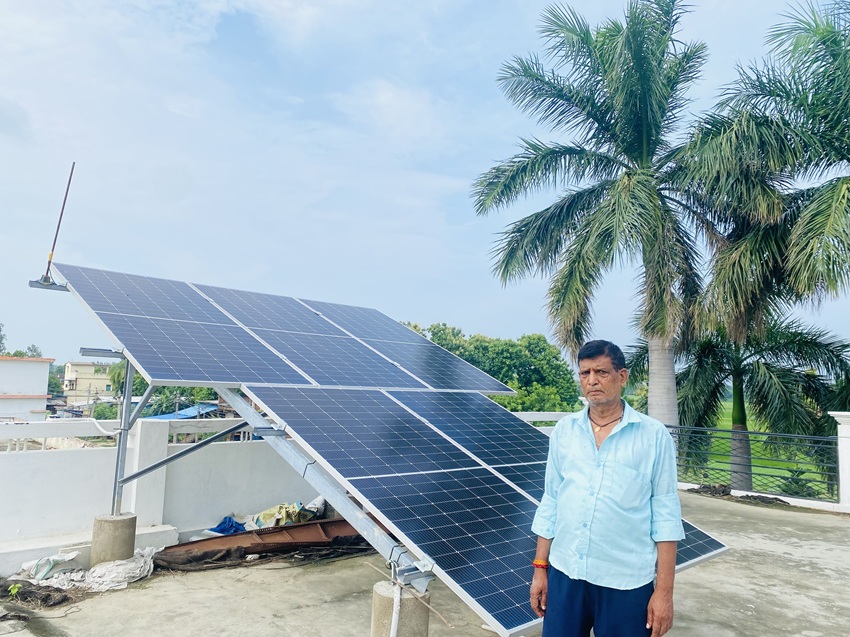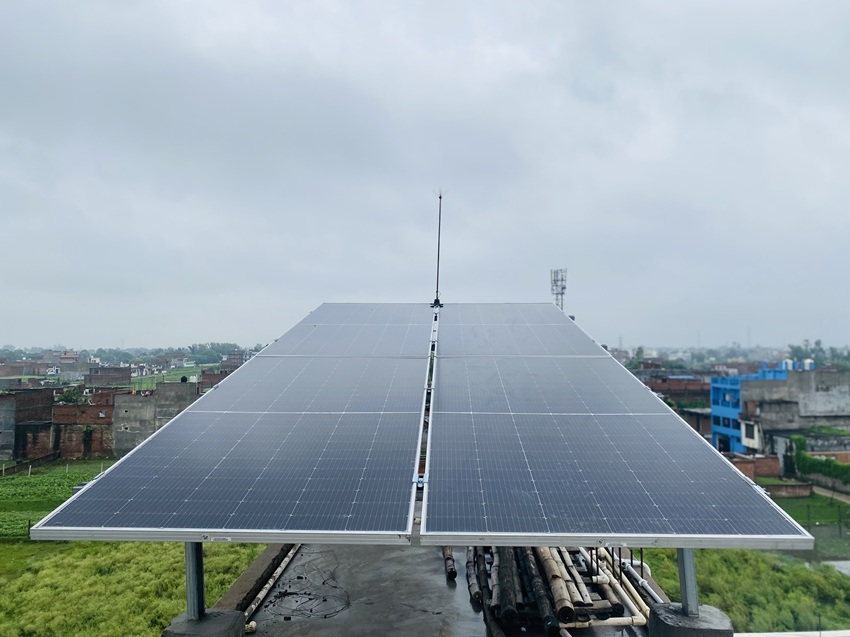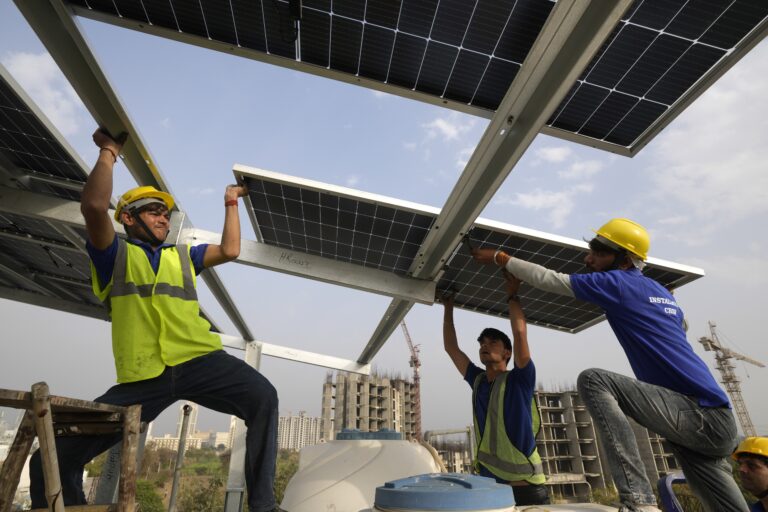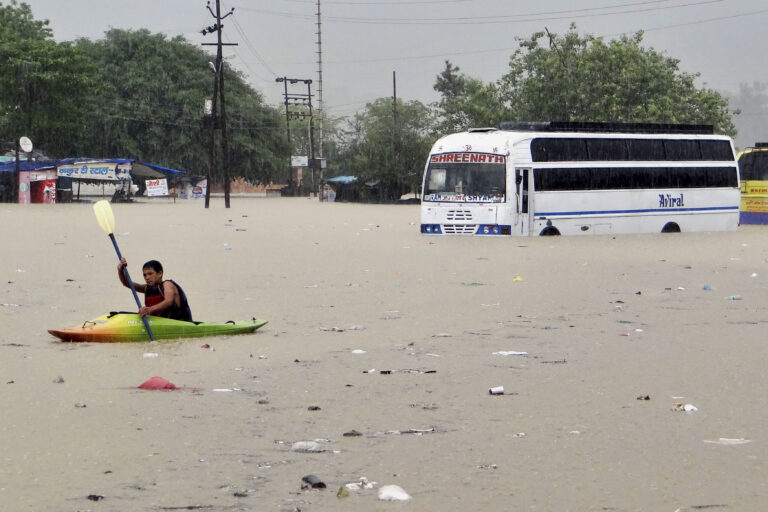- Uttar Pradesh (UP) has set an ambitious target for rooftop solar under the PM Surya Ghar Muft Bijli (PMSG) scheme.
- Across many districts in UP however, inflated or incorrect bills are the biggest complaints of people who have installed solar rooftop plants. Consumers are also frustrated by the low electricity output.
- There are key challenges, including delays in state subsidies and net meter configuration, substandard equipment, financing, and irregular power supply, to tackle.
When Ramesh Singh of Janipur, a village in Gorakhpur, Uttar Pradesh, installed a three-kilowatt (kW) solar rooftop plant on the terrace of his two-storey house last year, he expected his electricity bills to decrease and his power generation to meet his domestic needs. Initially, he received a minimal electricity bill, but in July he was shocked to get a bill of ₹12,269 for three months, much higher than what he had anticipated. “Earlier, I used to get a bill of about ₹700-800 per month. Now, despite the same load, I don’t understand how my bill has increased,” he said.
He is not alone. In the Khajani town of Gorakhpur district, Brijesh Modanwal installed a five-kW solar plant in April 2025, hoping for minimal bills. By July 7, he was shocked to receive a bill of ₹22,295 for three months. Similar complaints of inflated bills are emerging from across the state.
These consumer experiences highlight the gap between expectations and reality under the PM Surya Ghar: Muft Bijli Yojana (PMSG: MBY), launched in February 2024 with the aim of promoting rooftop solar in the country. While Uttar Pradesh has set ambitious targets and ranks one among the top three nationally in the project’s rollout, many districts are struggling to meet their goals, even as consumers grapple with inflated bills and other challenges.

Big push, uneven results
According to data from the Uttar Pradesh New and Renewable Energy Development Agency (UPNEDA), the state has set a target to install 2,65,211 residential rooftop solar plants by March 2026. Each of the 75 districts has its own target based on infrastructure and capacity.
As of July 15, however, only few districts are on track while most others are trailing. The top 15 districts include 10 municipal corporations that the state aims to develop as ‘solar cities.’ The state has drafted a policy to develop all 17 municipal corporations of Uttar Pradesh as ‘Solar Cities’. However, only 10 of those 17 municipal corporations rank among the 15 top-performing districts in implementing the PMSG: MBY.
Lucknow leads with 37,383 installations, almost double its target of 18,962 for this year. Varanasi, Prime Minister Narendra Modi’s constituency, also surpassed its annual target, with 15,548 installations against a target of 14,657. Kanpur Nagar has also performed strongly, installing 10,368 plants against a target of 4,000.
But in contrast, several key districts, including Agra, Bareilly, Prayagraj, Meerut, Muzaffarnagar, Gorakhpur, Ghaziabad, and Unnao, are falling short, and some may miss their overall targets by 2026. This is the status of the top 15 districts in terms of PMSG: MBY.
Despite this uneven progress, UPNEDA Director Inderjit Singh remains confident. “We have time till March 31, 2026, and all districts will achieve their targets by then,” he said.

Consumers’ concern
Consumers like Ramesh Singh and Brijesh Modanwal blame inflated bills, but officials offer different explanations. A representative of a private electricity metering company, which handles billing in Gorakhpur’s Kaudiram, said that Singh’s net meter had not yet been configured. “His is an existing net meter. It has yet to be configured to generate correct bills. Moreover, the smart meter works on a network basis. If there is no network, the meter will only show fixed charges, and the bill will reflect the same, which is why initially, some customers get very small bills,” said the representative who sits in Purvanchal Vidyut Vitaran Nigam Limited (PVVNL)’s office. The representative requested anonymity as they are not authorised to speak to the media.
For Modanwal, the sub-divisional officer at PVVNL, Bholanath said that the benefit of surplus electricity generated by his rooftop system would be adjusted only at the end of the financial year. He added that Modanwal’s solar rooftop plant also “appears to be of poor quality.”
Across districts, inflated or incorrect bills are among the most common complaints. Consumers are also frustrated by the poor quality of their plants’ output.
In Khajani, pharmacy owner Rajkumar Kasaudhan said his two-kW system produces barely five to six units a day against the 13 promised by his vendor. “If electricity is absent for seven to eight hours a day, the plant cannot deliver as expected,” he explained.
Officials acknowledge the problem but cite both faulty equipment and local weather as the reasons for low electricity production. Ashutosh Srivastava, Chief Engineer at PVVNL, also noted that some vendors are selling substandard solar power systems.
“Solar plants are performing very well in the Bundelkhand region, where the weather is extremely hot during the summer. The performance here (Gorakhpur) is not optimum,” added Bholanath.
Other challenges go beyond billing and generation. Vendors and consumers point to delays in state subsidies. A resident of Anandnagar, a town in the district of Maharajganj, vendor Virendra Jaiswal noted that his customers had received the central subsidy but were still waiting for the state’s contribution. One of them, Vidya Maurya, confirmed, “My three-kW plant was installed in February and I got ₹78,000 from the centre in three months, but I haven’t received ₹30,000 from the state.”
Chetan Singh Solanki, professor at the Department of Energy Science and Engineering, IIT Bombay, states that the primary challenge in implementing the PMSG: MBY is the energy illiteracy among various stakeholders, including government bodies, departments, officials, vendors, and consumers. “The way the scheme is being implemented is itself problematic. Most people tend to install solar power plants primarily to receive government subsidies and reduce their power bills, but once the plant is installed, they often increase their consumption. Rather than reducing their power consumption, most beneficiaries tend to install additional appliances, such as air conditioners, after installing a solar power plant. The design of the PMSGY is not good because it is based on the old model of just giving subsidies.”

He pointed out that vendors are often merely interested in making a profit, and they often install cheap equipment, especially in rural areas. They do not check whether there is ample sunlight available at the rooftop where they are installing a solar power plant.
Commenting on the underperformance of solar rooftop plants in districts like Gorakhpur, Solanki said that vendors often provide consumers in rural areas with cheap and untested equipment merely to sell their products and make a profit.
Jaideep Saraswat, Associate Director of Clean Power, Electric Mobility, and Emerging Technologies at Vasudha Foundation, which collaborates with the Uttar Pradesh government to promote clean energy applications and provides training to solar plant vendors in the state, also noted that people are not aware of how to utilise solar power plants. “Consumers are generally unaware of how to operate a solar power plant. They don’t clean the panel for days. A panel has to be regularly cleaned with a fibre cloth. Further, the idea that a panel will be clean after a rain shower is not completely true. At times, we see more soiling and hence, require immediate cleaning intervention,” he said.
Resistance from rural consumers
Vendors say adoption is especially slow in rural areas, where convincing people to install rooftop systems is difficult. Ajit Mishra, a Varanasi-based vendor of solar power plants explained that since these plants generate power only when electricity is present and several rural areas still lack a continuous electricity supply, convincing rural customers to install them is a major problem.
Financing is another major hurdle. Mishra said that many loan applications get stuck because of mismatches between the names in the electricity department records and the Aadhaar cards. “There are umpteen cases where names of consumers available with the electricity department are different from their actual names. Banks process loan applications only if the consumers’ names correspond to details in their Aadhaar cards, and the electricity department takes a long time to process name corrections. In many cases, consumers’ details have not been updated in the electricity department’s database after a customer’s death. These corrections too take time,” Mishra said said. As a result, several applications are pending. For instance, 192 loan applications given to banks by our company are pending in Varanasi — 70 in Bhadohi, 23 in Mirzapur, and 92 in Jaunpur.
Vendors also face resistance from consumers who fear higher bills. “In rural areas, many customers are not even accustomed to paying bills regularly. Also, where there is no need for an air conditioner (AC), consumers don’t feel the need to install a solar plant. In fact, installing solar rooftops may result in higher electricity bills if the smart meters are not configured to calculate the power units generated and consumed,” Mishra said.
However, Saraswat remains hopeful. “Any scheme of this stature will take time for implementation. There are key issues that need to be ironed out. All these issues have been communicated to the stakeholders, and district-level committees are in place to address them. Once we reach equilibrium, these will be ironed out, but we need to create awareness among consumers,” he said.
Read more: Rooftop solar extends deadline for target which is not a promising sign say experts
Banner image: Workers place a panel on the rooftop of a residence in Gurugram. (AP Photo/Manish Swarup)













